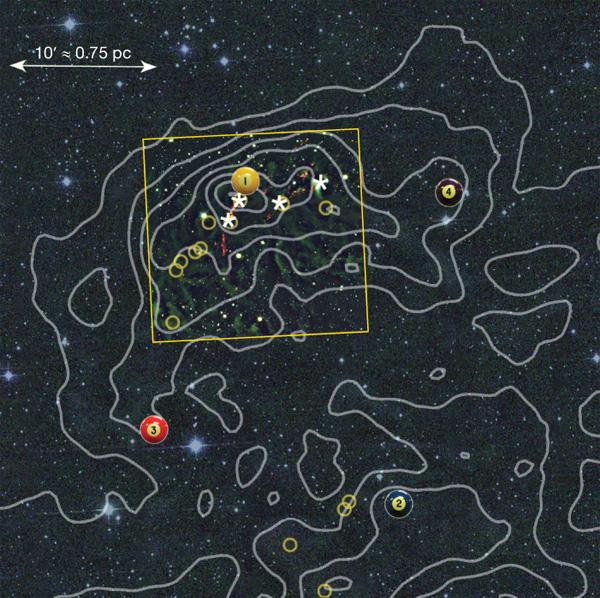
An infrared image of the star-forming cloud L1448. Astronomers have shown that self-gravity plays a key role in this source across large scales. The contours show the intensity of carbon monoxide emission. Other notation: numbered dots -- the locations of dense cores likely to produce future stars; asterisks -- the current young stars; circles -- regions where stars are almost but not yet born.
When a clump of interstellar gas and dust is small and dense enough, gravity plays a decisive role in turning that material into a new star. But what role does gravity play in shaping larger clouds of gas and dust, the ones that have not yet formed such dense cores? Is it perhaps primarily responsible for developing these cores in the first place? Astronomers do not yet know, but how stars form is a puzzle of great interest to them, and not only because we live around one. Young stars hold the clues to many cosmic wonders, from the production and dispersal of new elements to the illumination of distant galaxies whose properties trace cosmic history.
CfA astronomers Alyssa Goodman, Erik Rosolowsky, Jonathan Foster, Jens Kauffmann, and Jaime Pineda, along with two of their colleagues, have pioneered a new mathematical technique to address the role of gravity in producing the range of substructures seen in molecular clouds in which stars are forming. Writing in the current issue of of the journal Nature, the team describes how they analyze maps of these clouds made in the millimeter emission of carbon monoxide gas (an abundant constituent).
Their technique examines the hierarchical spatial relationships found between each intensity peak and its weaker, neighboring peaks, continuing on down to the faintest practical intensity levels. These relationships are then displayed graphically in a format that enables patterns to emerge; the astronomers then compare actual datasets with computer simulations. They argue that the interconnected patterns they are finding in sample clouds are the result of the cloud's gravity bringing its material closer together. Their results show that contrary to earlier models in which gravity was less important than some other processes (like turbulence), gravity plays a significant role that affects most of the material in a cloud, not just the material in the cores. If correct, the conclusion also implies that models of star formation will need to take gravity into account in a more realistic fashion. The electronic version of the paper is also the first publication in Nature to have a rotatable 3-D Adobe Acrobat figure the carbon monoxide data has velocity information that forms the 3rd coordinate of the image.)